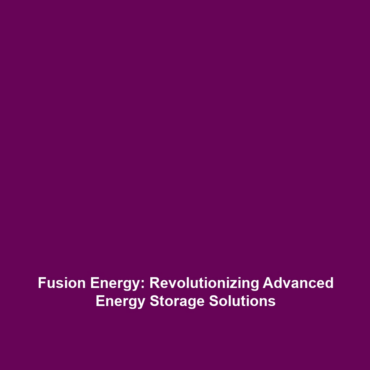<>
Energy Storage Solutions: Fusion Could Power Advanced Technologies
Introduction
As the world searches for sustainable energy sources, fusion energy has emerged as a groundbreaking solution with potential far beyond conventional energy generation. Energy storage solutions powered by fusion could revolutionize how we approach energy supply, particularly during peak demand periods. By integrating advanced technologies such as batteries and hydrogen production, fusion offers a promising strategy for ensuring a consistent energy supply. In this article, we will delve into how these advancements could shape the future of energy storage and contribute to a greener planet.
Key Concepts
The Science of Fusion Energy
Fusion energy is derived from the process of combining light atomic nuclei, such as hydrogen isotopes, to form heavier nuclei, which releases a significant amount of energy. This process occurs naturally in stars, including the sun, and offers numerous advantages over traditional energy sources:
- Abundant fuel supply: Hydrogen is readily available in water.
- Minimal environmental impact: Fusion generates little to no greenhouse gases.
- Safety: Fusion reactions do not produce long-lived radioactive waste.
Energy Storage Technologies
Energy storage solutions can take various forms, including:
- Batteries: Devices that store energy chemically for later use.
- Hydrogen production: Generating hydrogen through electrolysis for use as a clean fuel source.
Incorporating fusion energy into these technologies could enhance their effectiveness, allowing for greater storage capacity and efficiency.
Applications and Real-World Uses
The integration of fusion energy into advanced energy storage solutions has several practical applications:
- Batteries in Electric Vehicles (EVs): Fusion-powered batteries could significantly extend the range and lifespan of EVs.
- Energy Reserves: Fusion energy could be employed to store excess energy from renewable sources, ensuring stability in energy supply.
- Hydrogen Fuel Cells: Utilizing hydrogen produced from fusion energy for clean transportation and power generation.
These applications illustrate how energy storage solutions can leverage fusion to provide a reliable energy supply even during peak demand.
Current Challenges
Despite its potential, several challenges hinder the widespread adoption of energy storage solutions powered by fusion:
- Technological Limitations: Current fusion technologies are still in experimental stages and require significant advancements.
- Cost Factors: High initial investment and research costs associated with developing fusion-powered energy storage systems.
- Regulatory Hurdles: Navigating the regulatory landscape for energy production and storage technologies can be complex.
Understanding these challenges of energy storage solutions is essential for guiding research and innovation in the field.
Future Research and Innovations
Future research holds exciting possibilities for energy storage solutions within the context of fusion energy. Potential innovations include:
- Advanced Battery Chemistry: Development of more efficient materials that can withstand high-energy outputs.
- Next-Generation Fusion Reactors: Compact fusion reactors designed for energy storage applications.
- Hydrogen Production Techniques: Enhanced methods for producing hydrogen from fusion processes.
As research evolves, these breakthroughs may significantly impact the overall landscape of fusion energy.
Conclusion
In summary, the intersection of energy storage solutions and fusion energy presents a transformative opportunity for ensuring a reliable energy supply, particularly during peak demand events. By exploring advanced technologies, we can pave the way for a sustainable energy future. Stakeholders in the energy sector are encouraged to explore potential collaborations and investments in this burgeoning field. For more information on related topics, consider visiting our pages on batteries and hydrogen production.

Leave a Reply